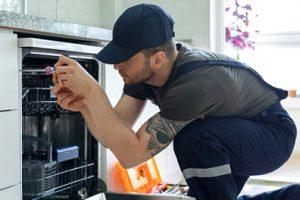Home appliances have become a crucial part of our daily lives in today’s fast-paced world. Our daily chores are made easier by these valuable equipment, which range from refrigerators and dishwashers to ovens and washing machines. However, like any machine, they can also face malfunctions. When faced with a faulty built-in home appliance, the first reaction could be to panic and run to a repair shop nearby. But what if you could take matters into your own hands? In this guide, as we delve into built-in home appliance repair, we’ll provide insightful advice on handling typical problems and cutting costs and time.

Tools we need
- Screwdrivers, pliers,
- Multimeter
- Nut Drivers
- Wire Cutters/Strippers
- Voltage Tester
- Flashlight
Common Built-In Home Appliance Issues and Solutions
Refrigerator Repair
Uneven cooling
If the fridge is producing uneven cooling, there might be an issue. Clean the condenser coils, check the gaskets for damage, and ensure proper ventilation around the appliance.
Water leakage
Examine the water supply line, drain pan, and defrost drain to identify and fix any leaks.
Excessive Frost Buildup:
Detecting a sizable ice buildup inside the freezer compartment might prevent appropriate cooling and result in less effective performance. Check the door seal/gasket for any gaps or tears. Replace the gasket if necessary to ensure a tight seal. Defrost the freezer by unplugging the refrigerator and allowing the ice to melt. Once melted, dry the interior thoroughly before plugging it back in.
Strange Noises
Unusual noises from the refrigerator, such as buzzing, rattling, or squeaking, can be disruptive and indicate a potential problem. Check if the refrigerator is level. Adjust the leveling feet to ensure it is stable and balanced, which can reduce vibrations and noise. Inspect the condenser fan and evaporator fan for any obstructions or signs of damage. Clean or replace the fans if necessary to eliminate noise.
Dishwasher Repair
Poor cleaning performance
Inspect the spray arms for clogs, clean the filters, and ensure adequate water temperature.
Water drainage issues
Clean the drain hose, unclog the garbage disposal, and check the pump and motor for any obstructions.
Foul Odors
Food residue, mold, or bacterial development within the dishwasher may be the source of persistently offensive odors. To get rid of any food or debris stuck in the dishwasher filter, clean it. To eliminate odor-causing germs and freshen the dishwasher, cycle with a dishwasher-safe cleaning product or vinegar and baking soda solution.
Inadequate Cleaning
Dishes that still have residue or food particles after a cycle may not be cleaned thoroughly, which may point to a performance issue with the dishwasher. Check the spray arms for obstructions or clogs. Debris or mineral buildup impacting the spray pattern should be removed. Ensure the water input valve operates properly and supplies enough water pressure by checking it. If necessary, clean the valve or replace it.
Oven Repair
Uneven heating
Test the oven’s temperature sensor, calibrate the thermostat, and check for damaged heating elements.
Faulty ignition
Examine the igniter, burner, and control board to diagnose and address ignition problems.
Faulty Oven Door
Heat loss, ineffective cooking, and significant safety risks might result from an open oven door, out of alignment, or otherwise broken. Verify the springs and hinges for deterioration or alignment issues. If required, tighten slack screws and adjust the hinges. Replace the door seal (gasket) if damaged or worn to guarantee a tight seal that keeps temperatures where they should be and avoids heat loss.
Washing Machine Repair
Excessive vibrations
Level the machine and check for worn-out suspension rods or damaged shock absorbers.
Water leakage
Inspect the hoses, door gaskets, and the water inlet valve for leaks or blockages.
Excessive Noise
Unusual noises during the washing machine’s operation, such as banging, grinding, or squeaking, can be disruptive and indicate a problem. Check for loose or worn-out components, such as the motor mounts, drum bearings, or suspension springs. Tighten or replace them as needed. Inspect the drum or tub for foreign objects, such as coins or small items, which may cause noise during spinning. Remove any obstructions.
Failure to Drain
If the washer doesn’t discharge the water properly after a cycle, it can result in standing water inside the drum and prevent subsequent cycles from starting. Check the drain hose for any clogs. Straighten or clean the hose to ensure smooth water flow. Inspect the drain pump for any debris or blockages. Clear the pump of any obstructions and ensure it is functioning correctly. If necessary, replace the pump.
When to Seek Professional Help
While tackling built-in home appliance repair can save you money, there are instances when it’s best to seek professional assistance. Consider the following situations:
Lack of technical knowledge
Consulting a professional is better if you’re unsure about the repair process or lack experience with electrical or mechanical systems.
Safety concerns
If the repair involves intricate electrical work or poses potential hazards, it’s best to leave it to the experts.
Warranty coverage
Attempting repairs may void the warranty if your appliance is still under warranty. Consult the manufacturer or authorized service centers in such cases.
Conclusion
Mastering built-in home appliance repair can be a valuable skill that saves you time and money. You can confidently approach repairs by familiarizing yourself with the basics, troubleshooting techniques, and common issues various appliances face.
However, always prioritize safety and know your limitations. Don’t hesitate to contact a professional appliance repair service near you. With the right knowledge and approach, you can become a DIY hero and keep your home appliances in top-notch condition for years.







